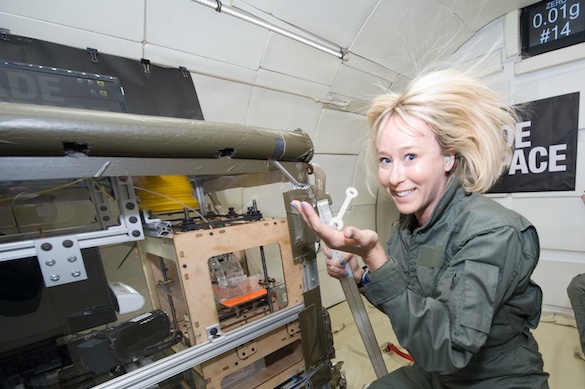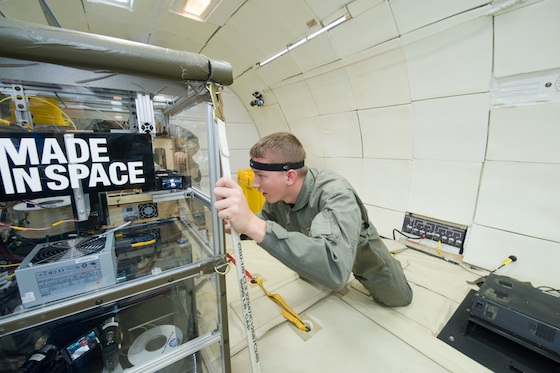Printing the Space Future
PI: Jason Dunn, Made in Space, Inc.
PI: Jason Dunn, Made in Space, Inc.

- TA07 Human Exploration Destination Systems
- TA12 Materials, Structures, Mechanical Systems and Manufacturing
3D printing, also known as additive manufacturing, is an emergent technology originally developed to rapidly manufacture prototype parts. In contrast to subtractive manufacturing, where material is cut away to produce a part, 3D printers build a product bit by bit (often one layer or cross section at a time), and thus little material is wasted. Every part is built from a CAD (computer aided design) file, making the conception and creation a simple two stage process. Additionally, there are very few geometrical restrictions, and parts can be produced that would be impossible through conventional manufacturing methods. Examples include optimally designed structures that exhibit low mass, high strength characteristics, and designs with complicated features built right into the part. While 3D printing on earth is becoming a more utilized manufacturing solution, the potential benefits for space are intuitive and extensive.
The purpose of these flights is to demonstrate and enable 3D printing as a viable in-situ technology to be utilized as a tool for manufacturing in space and on other planets. The direct objectives of the proposed experiments are to build upon previous flight research and to raise the TRL level of FDM 3D printing.
NASA
Commercial Space
The previous research will be built upon in three ways. New machines will be tested to verify earlier results on modern hardware, geometries will be printed that will verify whether unsupported structures can be built in micro-gravity, and the results will be analyzed post-flight through stress tests and under high powered microscope to conclude whether structures printed in zero gravity match those on earth in both strength and composition.
Three experiments will be tested during the flight:
1. The experimental Extended Structure Additive Manufacturing Machine (ESAMM), which will demonstrate the unique concept of printing extended structures. To test the extended structure concept, the ESAMM will print a core sample that will be operating throughout the entire flight. This will create a part that has been built in zero-gravity, two-gravity, and everything in between—allowing post-flight analysis across all the different gravitational loads.
2. A COTS extrusion 3D printer (Bits For Bytes’ BFB 3000), which will build a generative design structure optimized for the least amount of material used. A ground-based printer will also have printed the same part, allowing for post-flight comparison to a one-g and zero-g part.
3. A second COTS extrusion 3D printer (MakerBot), which will build a structure that doesn’t have or need a surface to print on. This printer will extrude material across two beams with no support in between, demonstrating the capabilities to build without necessary support material.
The three experiments will be mounted in a uniform flight box equipped with video cameras to collect data. All experiments will be visually monitored by the flight crew. The top deck houses the ESAMM and MakerBot printers. The bottom deck houses the BFB3000.

During the Summer of 2011, Made in Space, Inc. tested the effects of microgravity on 3D printers in a total of three weeks of microgravity testing. The testing took place during flight campaigns in the months of July, August and September onboard the Zero-G aircraft.
Various 3D printers were flown, as well as multiple individual sub-components, all with the goal to:
- Confirm that extrusion‐based 3D printing works in microgravity
- Determine how effective the extrusion-based 3D printing process is in microgravity compared to ground‐based printing
- Research and understand the fundamental physics of 3D printing in microgravity.
The flight opportunity provided to Made in Space was successful by many standards. Made in Space was able to further demonstrate the capabilities of additive manufacturing in microgravity environments. The microgravity flights also enabled the TRL of the technology to be pushed even further.
Samples built during the flight were analyzed microscopically to compare layer resolution to parts built on the ground. Additional destructive tests on parts were conducted to gather data on internal structure as well as tensile and loading strengths.
The Flight Opportunities Program provided by NASA’s OCT has been fundamental in the growth of the company, and allows Made in Space to move forward effectively towards bringing 3D printing to the space environment with a fast-track approach. Using data gathered through the flight campaigns, Made in Space is currently building a 3D printer to fly on the ISS.
Technology Details
-
Selection DateAFO1 (May 2011)
-
Program StatusCompleted
- 5 Parabolic
- 0 sRLV
Development Team
-
PIJason Dunn
-
OrganizationMade in Space, Inc.
-
SponsorNASA
-
PartnersAutodesk
-
More Information

